Report: 3D Printing Technologies, Manufacturing, and Industry Impact
VerifiedAdded on 2020/05/03
|10
|2000
|78
Report
AI Summary
This report provides an overview of 3D printing, also known as additive manufacturing. It explores the process of creating solid objects from digital designs, highlighting its advantages in low-volume manufacturing and rapid prototyping. The report discusses various applications across consumer goods, industrial, healthcare sectors. It covers the importance of 3D printing in mass customization, medical applications, and industrial design. The report also analyzes market forecasts and the potential of 3D printing to make traditional manufacturing obsolete. It recommends the adoption of 3D printing technologies for enhanced manufacturing capabilities, focusing on safety and quality. The report concludes with the role of online platforms in supporting the 3D printing community.

report
Paraphrase This Document
Need a fresh take? Get an instant paraphrase of this document with our AI Paraphraser
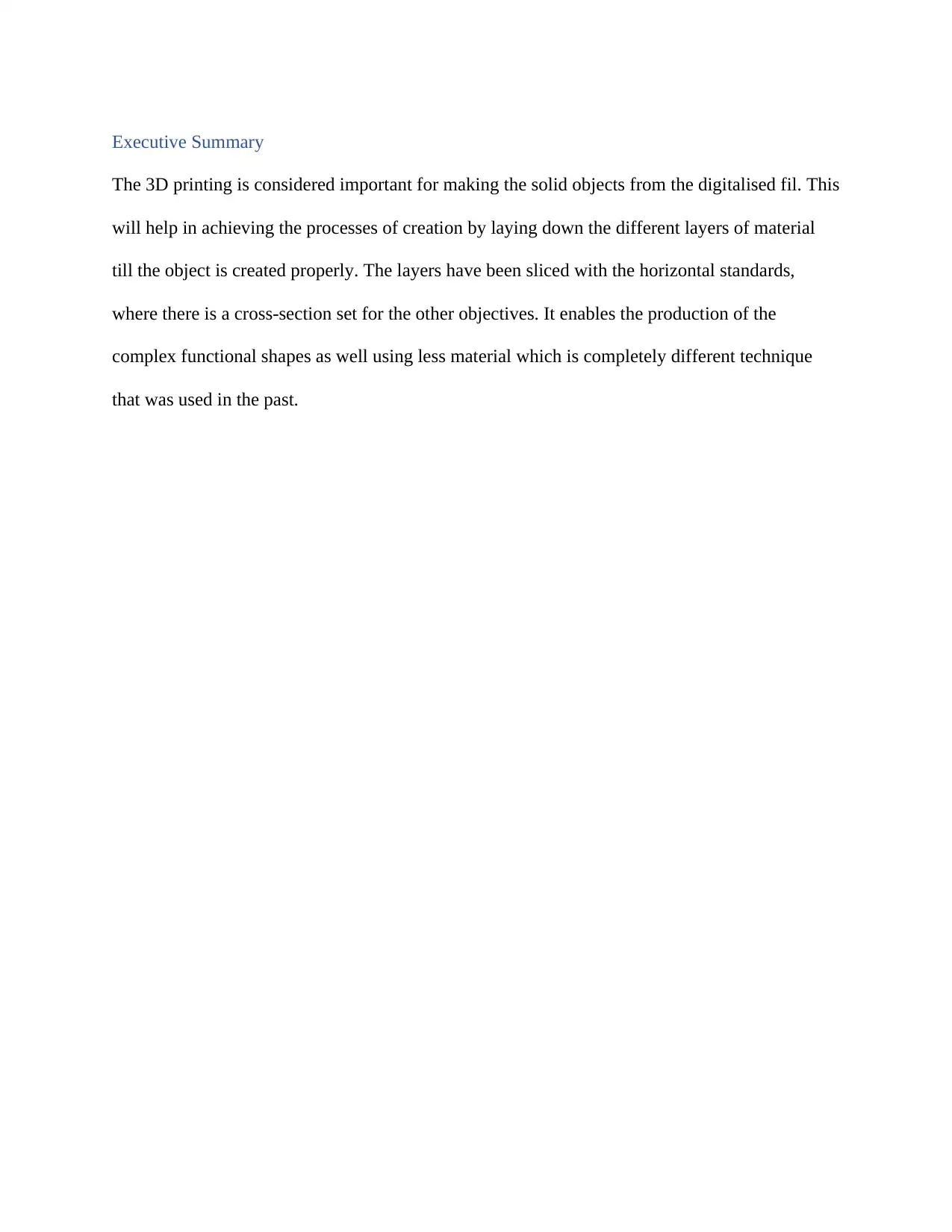
Executive Summary
The 3D printing is considered important for making the solid objects from the digitalised fil. This
will help in achieving the processes of creation by laying down the different layers of material
till the object is created properly. The layers have been sliced with the horizontal standards,
where there is a cross-section set for the other objectives. It enables the production of the
complex functional shapes as well using less material which is completely different technique
that was used in the past.
The 3D printing is considered important for making the solid objects from the digitalised fil. This
will help in achieving the processes of creation by laying down the different layers of material
till the object is created properly. The layers have been sliced with the horizontal standards,
where there is a cross-section set for the other objectives. It enables the production of the
complex functional shapes as well using less material which is completely different technique
that was used in the past.
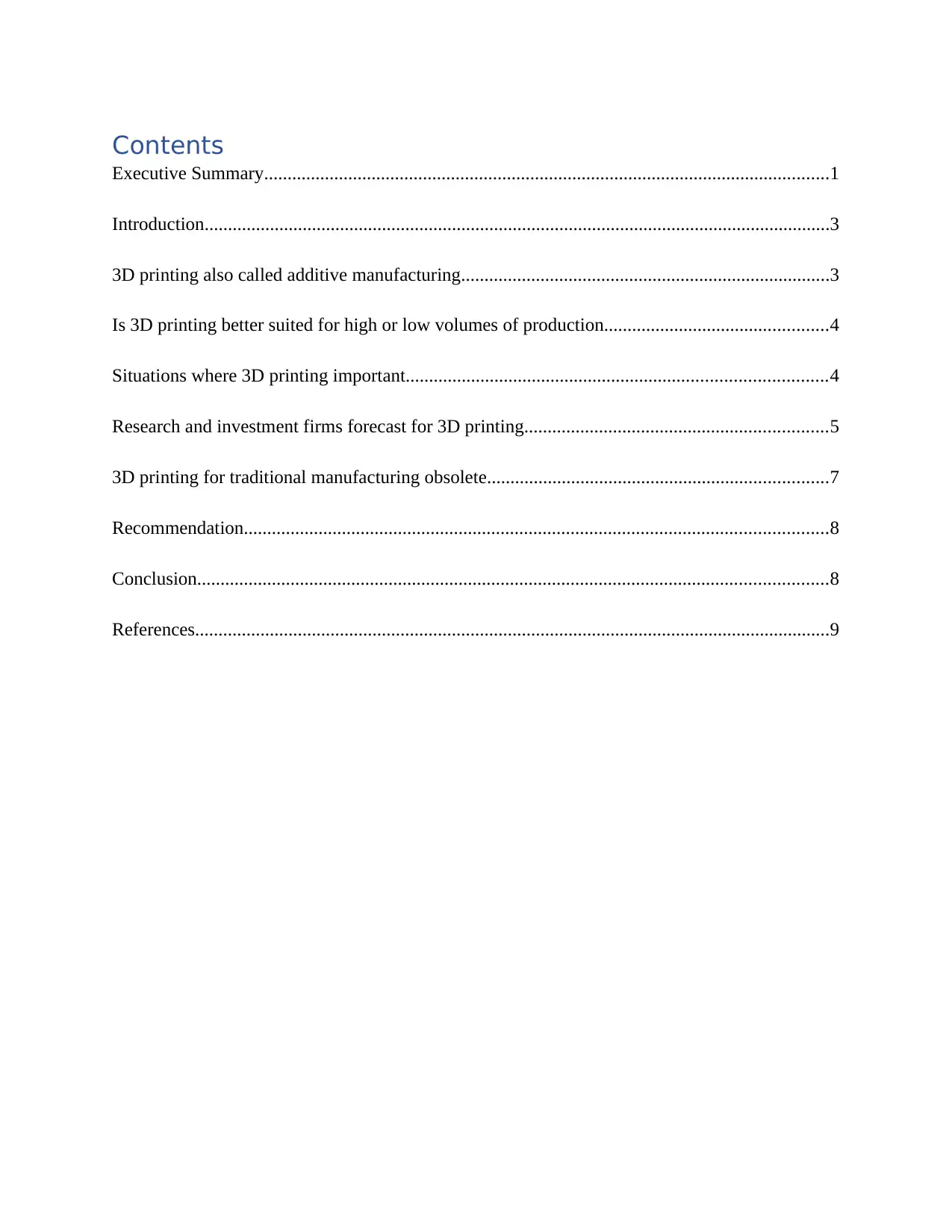
Contents
Executive Summary.........................................................................................................................1
Introduction......................................................................................................................................3
3D printing also called additive manufacturing...............................................................................3
Is 3D printing better suited for high or low volumes of production................................................4
Situations where 3D printing important..........................................................................................4
Research and investment firms forecast for 3D printing.................................................................5
3D printing for traditional manufacturing obsolete.........................................................................7
Recommendation.............................................................................................................................8
Conclusion.......................................................................................................................................8
References........................................................................................................................................9
Executive Summary.........................................................................................................................1
Introduction......................................................................................................................................3
3D printing also called additive manufacturing...............................................................................3
Is 3D printing better suited for high or low volumes of production................................................4
Situations where 3D printing important..........................................................................................4
Research and investment firms forecast for 3D printing.................................................................5
3D printing for traditional manufacturing obsolete.........................................................................7
Recommendation.............................................................................................................................8
Conclusion.......................................................................................................................................8
References........................................................................................................................................9
⊘ This is a preview!⊘
Do you want full access?
Subscribe today to unlock all pages.

Trusted by 1+ million students worldwide

Introduction
3D printing works over the digital designing where the model is to create a proper modelling
software where the data is generated with the 3D scanner. This helps in working over the blender
and handling the slicing which is for the 3D model into different horizontal layers which is
important as well. This is also important to force the use of different slicing tools for the 3D
printer where the scanner is used layer by layer to work for processing the video. The 3D
printing is important for the consumer goods, industrial, high tech services and the health care
sectors as well (Campbell et al., 2011). This is through becoming intertwined through the daily
operations with the use of 3D printing structures where the company focus on the research,
development and prototyping as well.
3D printing also called additive manufacturing
This is so mainly because it creates the physical objects from the digital designing. There are
different technologies and the materials that could be used for the printing and to handle the
digital models that are set to turn into the solid 3-D physical objects by addition of the material
layer by layer. With this, for every object, there is a need of printing the documents over the
paper where the printing process mainly varies by the technology. This refers to the process of
creating the layers of material which are under the computer control to create the objects. Here,
the objects can easily be set with the production using the digital model data from the 3D model
(Weller et al, 2015). The standards are set for the material which are removed from the stock in
the conventional machining process where the AM tends to work from the CAD designing or the
AMF files by the addition of the material layer by layer.
3D printing works over the digital designing where the model is to create a proper modelling
software where the data is generated with the 3D scanner. This helps in working over the blender
and handling the slicing which is for the 3D model into different horizontal layers which is
important as well. This is also important to force the use of different slicing tools for the 3D
printer where the scanner is used layer by layer to work for processing the video. The 3D
printing is important for the consumer goods, industrial, high tech services and the health care
sectors as well (Campbell et al., 2011). This is through becoming intertwined through the daily
operations with the use of 3D printing structures where the company focus on the research,
development and prototyping as well.
3D printing also called additive manufacturing
This is so mainly because it creates the physical objects from the digital designing. There are
different technologies and the materials that could be used for the printing and to handle the
digital models that are set to turn into the solid 3-D physical objects by addition of the material
layer by layer. With this, for every object, there is a need of printing the documents over the
paper where the printing process mainly varies by the technology. This refers to the process of
creating the layers of material which are under the computer control to create the objects. Here,
the objects can easily be set with the production using the digital model data from the 3D model
(Weller et al, 2015). The standards are set for the material which are removed from the stock in
the conventional machining process where the AM tends to work from the CAD designing or the
AMF files by the addition of the material layer by layer.
Paraphrase This Document
Need a fresh take? Get an instant paraphrase of this document with our AI Paraphraser
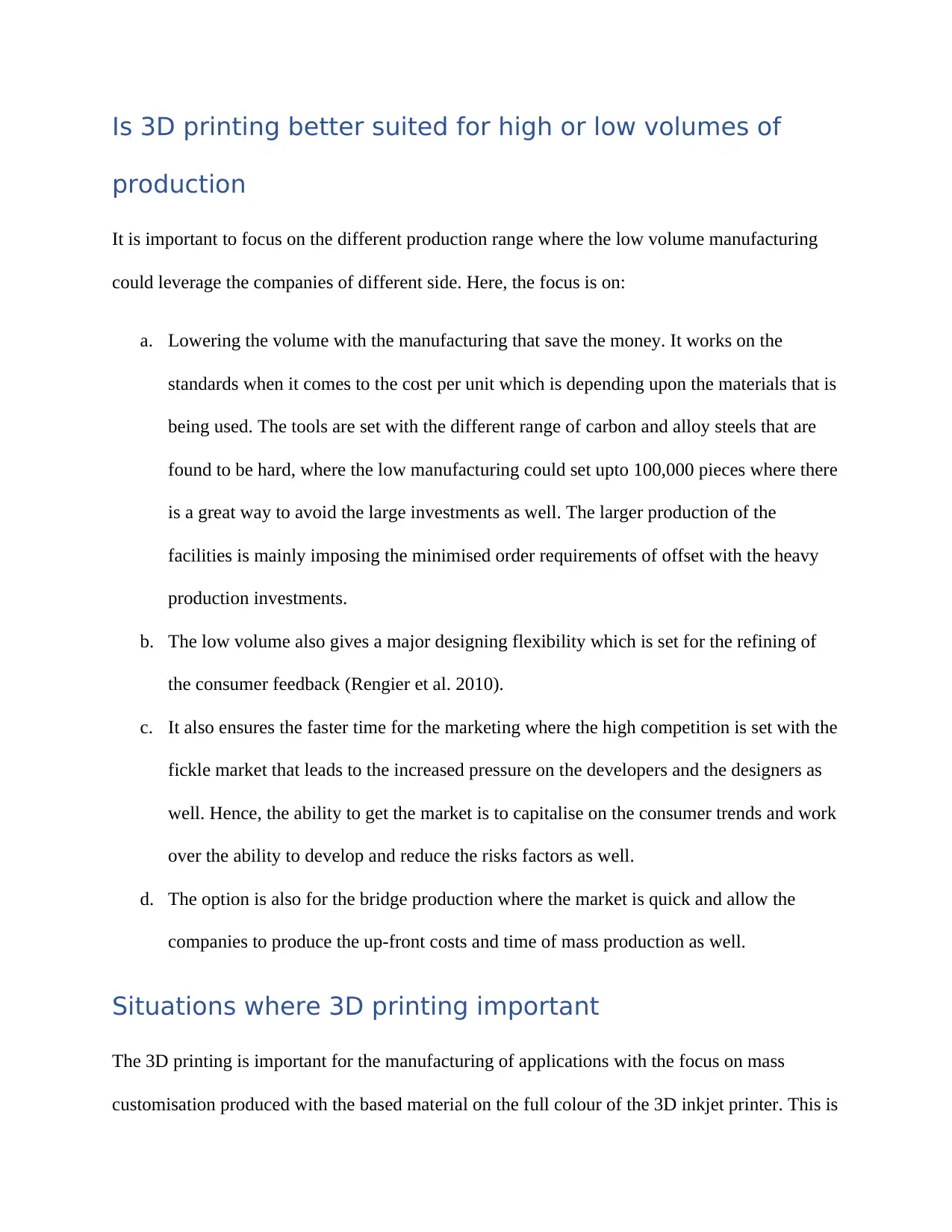
Is 3D printing better suited for high or low volumes of
production
It is important to focus on the different production range where the low volume manufacturing
could leverage the companies of different side. Here, the focus is on:
a. Lowering the volume with the manufacturing that save the money. It works on the
standards when it comes to the cost per unit which is depending upon the materials that is
being used. The tools are set with the different range of carbon and alloy steels that are
found to be hard, where the low manufacturing could set upto 100,000 pieces where there
is a great way to avoid the large investments as well. The larger production of the
facilities is mainly imposing the minimised order requirements of offset with the heavy
production investments.
b. The low volume also gives a major designing flexibility which is set for the refining of
the consumer feedback (Rengier et al. 2010).
c. It also ensures the faster time for the marketing where the high competition is set with the
fickle market that leads to the increased pressure on the developers and the designers as
well. Hence, the ability to get the market is to capitalise on the consumer trends and work
over the ability to develop and reduce the risks factors as well.
d. The option is also for the bridge production where the market is quick and allow the
companies to produce the up-front costs and time of mass production as well.
Situations where 3D printing important
The 3D printing is important for the manufacturing of applications with the focus on mass
customisation produced with the based material on the full colour of the 3D inkjet printer. This is
production
It is important to focus on the different production range where the low volume manufacturing
could leverage the companies of different side. Here, the focus is on:
a. Lowering the volume with the manufacturing that save the money. It works on the
standards when it comes to the cost per unit which is depending upon the materials that is
being used. The tools are set with the different range of carbon and alloy steels that are
found to be hard, where the low manufacturing could set upto 100,000 pieces where there
is a great way to avoid the large investments as well. The larger production of the
facilities is mainly imposing the minimised order requirements of offset with the heavy
production investments.
b. The low volume also gives a major designing flexibility which is set for the refining of
the consumer feedback (Rengier et al. 2010).
c. It also ensures the faster time for the marketing where the high competition is set with the
fickle market that leads to the increased pressure on the developers and the designers as
well. Hence, the ability to get the market is to capitalise on the consumer trends and work
over the ability to develop and reduce the risks factors as well.
d. The option is also for the bridge production where the market is quick and allow the
companies to produce the up-front costs and time of mass production as well.
Situations where 3D printing important
The 3D printing is important for the manufacturing of applications with the focus on mass
customisation produced with the based material on the full colour of the 3D inkjet printer. This is

also used in the additive manufacturing of the food into 3D objects like the chocolates and the
candy etc. The medical applications make use of the 3D printing for the surgery where the virtual
planning is mainly applied in the areas which include the creation of the unique and the patient
matched devices for rare illness. The bio-printing is also considered to be done through this
where the applications are set under the field of research with organ printing, bio printing and the
body party printing. The possibility is to use the 3D tissue which is mainly to create the soft
tissue for the reconstructive surgery. The industrial applications like the apparels make use for
the custom fit and the styling (Lam et al., 2002). This is mainly on-demand customisation of the
glasses with the rapid prototyping. Here, the industrial art and the jewellery makes use of the
personalised models of the art and the dolls. There are different shapes in metal or plastic with
the consumable art like the 3D printed chocolates. The construction and the firearms make use of
the 3D printing to produce the scale models with the architecture that has the increased stability
with the reduced costs of the 3D printers. The applications are to fabricate and work on the entire
designing, development of the new technologies as well.
Research and investment firms forecast for 3D printing
As per the market forecast, the GE plans to work on mass production with LEAP Engine nozzles
with the forecasting of the growth by the equity research. The 3D printing works on the
acceleration of the product development with customised products with increased production
flexibility (Bak, 2003). The improved spare parts managements work on accelerating and
offering the customised products.
candy etc. The medical applications make use of the 3D printing for the surgery where the virtual
planning is mainly applied in the areas which include the creation of the unique and the patient
matched devices for rare illness. The bio-printing is also considered to be done through this
where the applications are set under the field of research with organ printing, bio printing and the
body party printing. The possibility is to use the 3D tissue which is mainly to create the soft
tissue for the reconstructive surgery. The industrial applications like the apparels make use for
the custom fit and the styling (Lam et al., 2002). This is mainly on-demand customisation of the
glasses with the rapid prototyping. Here, the industrial art and the jewellery makes use of the
personalised models of the art and the dolls. There are different shapes in metal or plastic with
the consumable art like the 3D printed chocolates. The construction and the firearms make use of
the 3D printing to produce the scale models with the architecture that has the increased stability
with the reduced costs of the 3D printers. The applications are to fabricate and work on the entire
designing, development of the new technologies as well.
Research and investment firms forecast for 3D printing
As per the market forecast, the GE plans to work on mass production with LEAP Engine nozzles
with the forecasting of the growth by the equity research. The 3D printing works on the
acceleration of the product development with customised products with increased production
flexibility (Bak, 2003). The improved spare parts managements work on accelerating and
offering the customised products.
⊘ This is a preview!⊘
Do you want full access?
Subscribe today to unlock all pages.

Trusted by 1+ million students worldwide
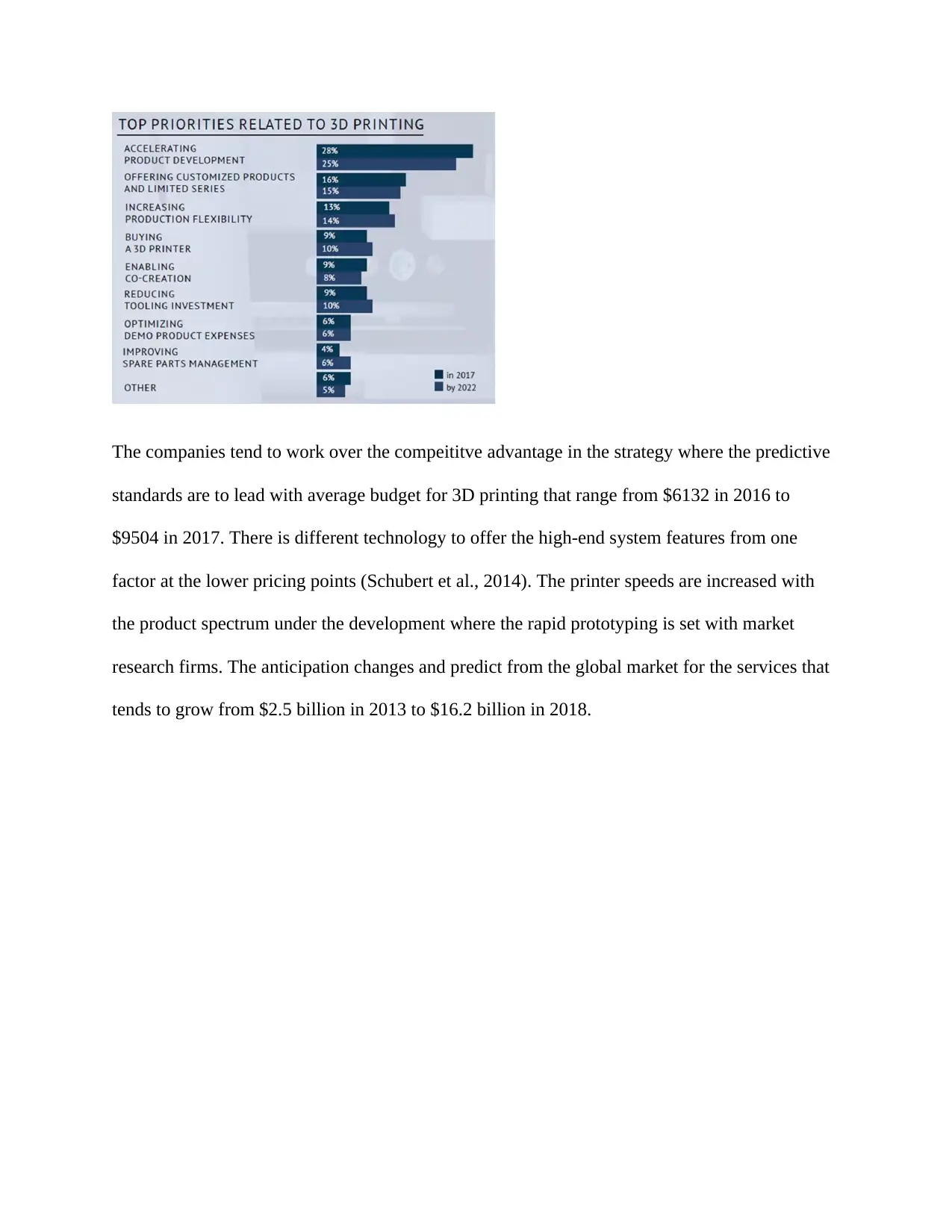
The companies tend to work over the compeititve advantage in the strategy where the predictive
standards are to lead with average budget for 3D printing that range from $6132 in 2016 to
$9504 in 2017. There is different technology to offer the high-end system features from one
factor at the lower pricing points (Schubert et al., 2014). The printer speeds are increased with
the product spectrum under the development where the rapid prototyping is set with market
research firms. The anticipation changes and predict from the global market for the services that
tends to grow from $2.5 billion in 2013 to $16.2 billion in 2018.
standards are to lead with average budget for 3D printing that range from $6132 in 2016 to
$9504 in 2017. There is different technology to offer the high-end system features from one
factor at the lower pricing points (Schubert et al., 2014). The printer speeds are increased with
the product spectrum under the development where the rapid prototyping is set with market
research firms. The anticipation changes and predict from the global market for the services that
tends to grow from $2.5 billion in 2013 to $16.2 billion in 2018.
Paraphrase This Document
Need a fresh take? Get an instant paraphrase of this document with our AI Paraphraser
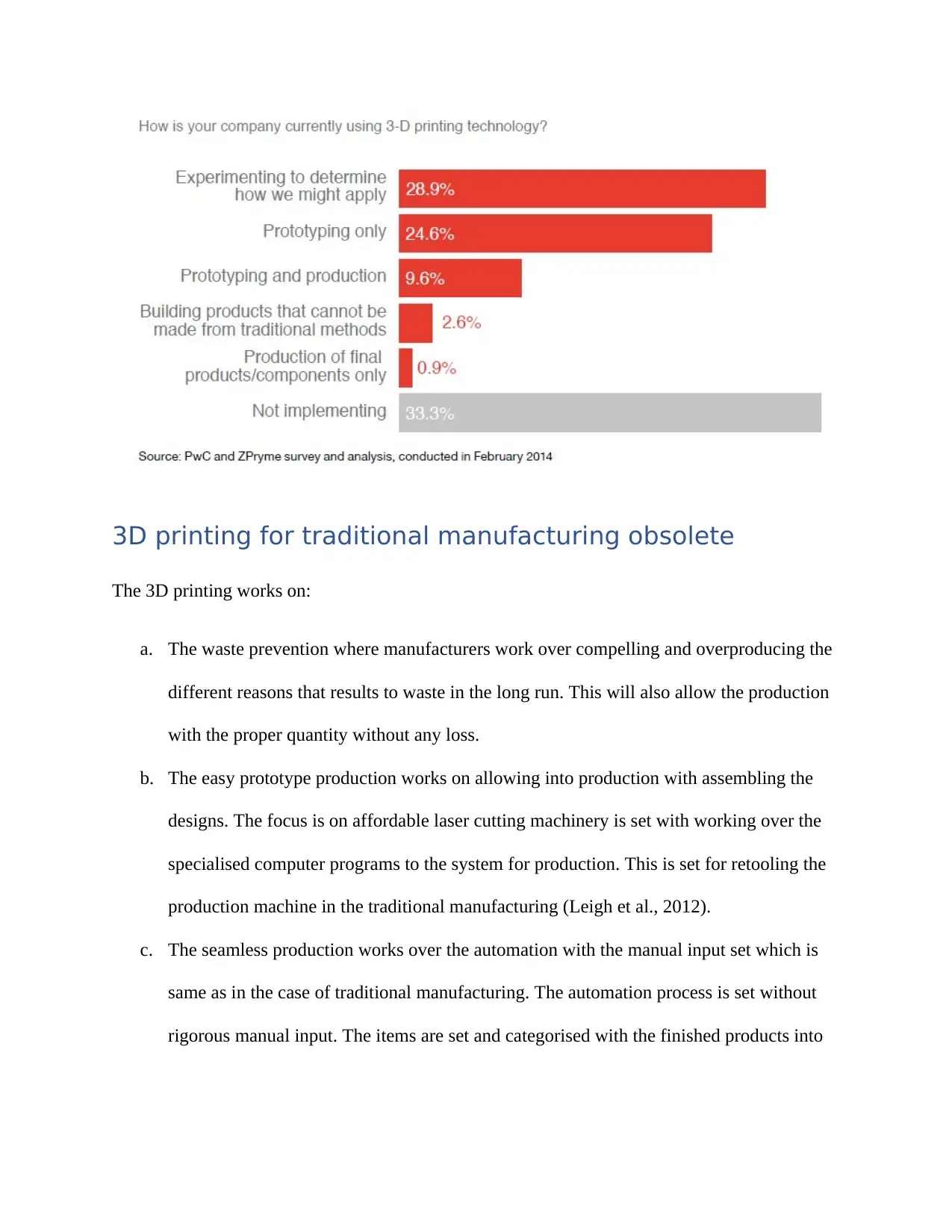
3D printing for traditional manufacturing obsolete
The 3D printing works on:
a. The waste prevention where manufacturers work over compelling and overproducing the
different reasons that results to waste in the long run. This will also allow the production
with the proper quantity without any loss.
b. The easy prototype production works on allowing into production with assembling the
designs. The focus is on affordable laser cutting machinery is set with working over the
specialised computer programs to the system for production. This is set for retooling the
production machine in the traditional manufacturing (Leigh et al., 2012).
c. The seamless production works over the automation with the manual input set which is
same as in the case of traditional manufacturing. The automation process is set without
rigorous manual input. The items are set and categorised with the finished products into
The 3D printing works on:
a. The waste prevention where manufacturers work over compelling and overproducing the
different reasons that results to waste in the long run. This will also allow the production
with the proper quantity without any loss.
b. The easy prototype production works on allowing into production with assembling the
designs. The focus is on affordable laser cutting machinery is set with working over the
specialised computer programs to the system for production. This is set for retooling the
production machine in the traditional manufacturing (Leigh et al., 2012).
c. The seamless production works over the automation with the manual input set which is
same as in the case of traditional manufacturing. The automation process is set without
rigorous manual input. The items are set and categorised with the finished products into
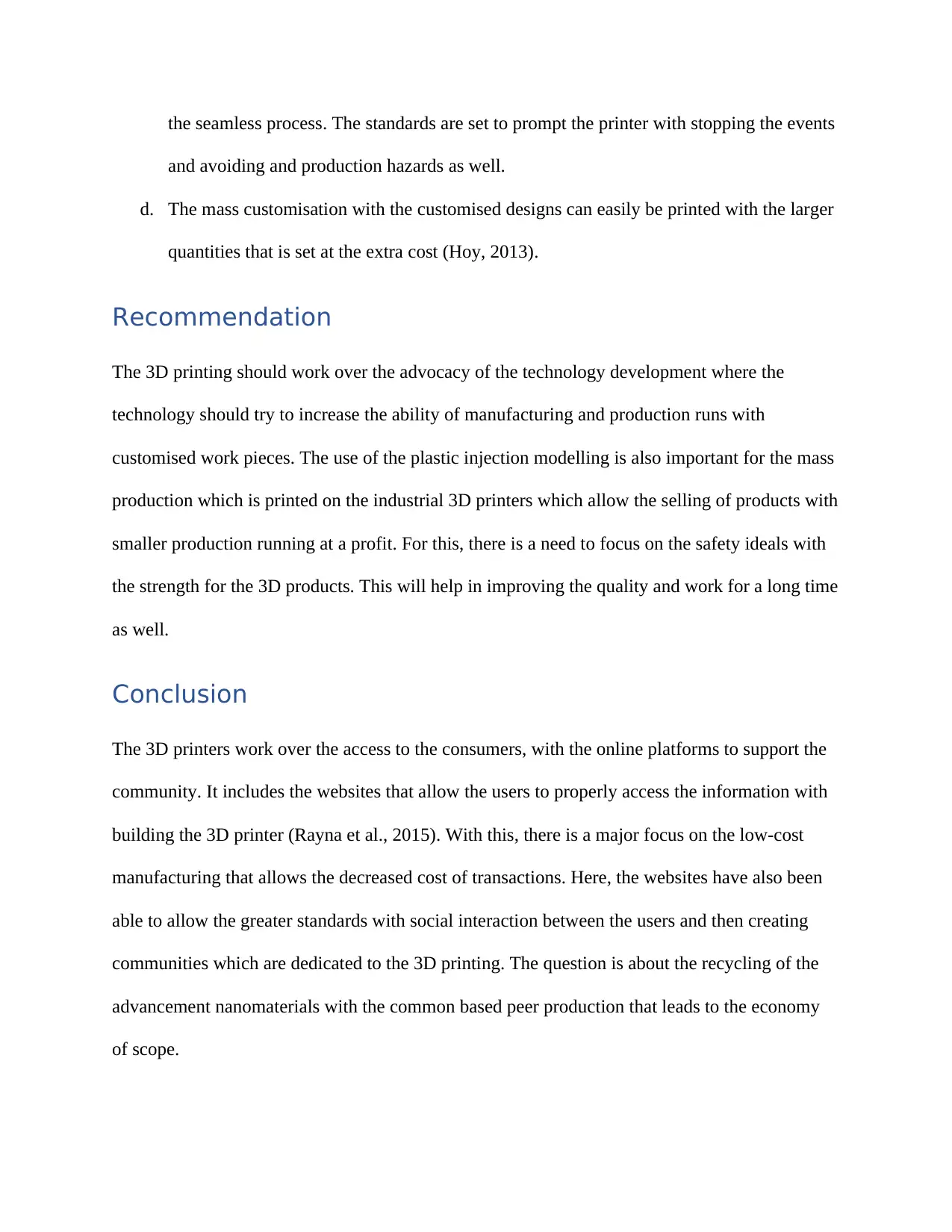
the seamless process. The standards are set to prompt the printer with stopping the events
and avoiding and production hazards as well.
d. The mass customisation with the customised designs can easily be printed with the larger
quantities that is set at the extra cost (Hoy, 2013).
Recommendation
The 3D printing should work over the advocacy of the technology development where the
technology should try to increase the ability of manufacturing and production runs with
customised work pieces. The use of the plastic injection modelling is also important for the mass
production which is printed on the industrial 3D printers which allow the selling of products with
smaller production running at a profit. For this, there is a need to focus on the safety ideals with
the strength for the 3D products. This will help in improving the quality and work for a long time
as well.
Conclusion
The 3D printers work over the access to the consumers, with the online platforms to support the
community. It includes the websites that allow the users to properly access the information with
building the 3D printer (Rayna et al., 2015). With this, there is a major focus on the low-cost
manufacturing that allows the decreased cost of transactions. Here, the websites have also been
able to allow the greater standards with social interaction between the users and then creating
communities which are dedicated to the 3D printing. The question is about the recycling of the
advancement nanomaterials with the common based peer production that leads to the economy
of scope.
and avoiding and production hazards as well.
d. The mass customisation with the customised designs can easily be printed with the larger
quantities that is set at the extra cost (Hoy, 2013).
Recommendation
The 3D printing should work over the advocacy of the technology development where the
technology should try to increase the ability of manufacturing and production runs with
customised work pieces. The use of the plastic injection modelling is also important for the mass
production which is printed on the industrial 3D printers which allow the selling of products with
smaller production running at a profit. For this, there is a need to focus on the safety ideals with
the strength for the 3D products. This will help in improving the quality and work for a long time
as well.
Conclusion
The 3D printers work over the access to the consumers, with the online platforms to support the
community. It includes the websites that allow the users to properly access the information with
building the 3D printer (Rayna et al., 2015). With this, there is a major focus on the low-cost
manufacturing that allows the decreased cost of transactions. Here, the websites have also been
able to allow the greater standards with social interaction between the users and then creating
communities which are dedicated to the 3D printing. The question is about the recycling of the
advancement nanomaterials with the common based peer production that leads to the economy
of scope.
⊘ This is a preview!⊘
Do you want full access?
Subscribe today to unlock all pages.

Trusted by 1+ million students worldwide
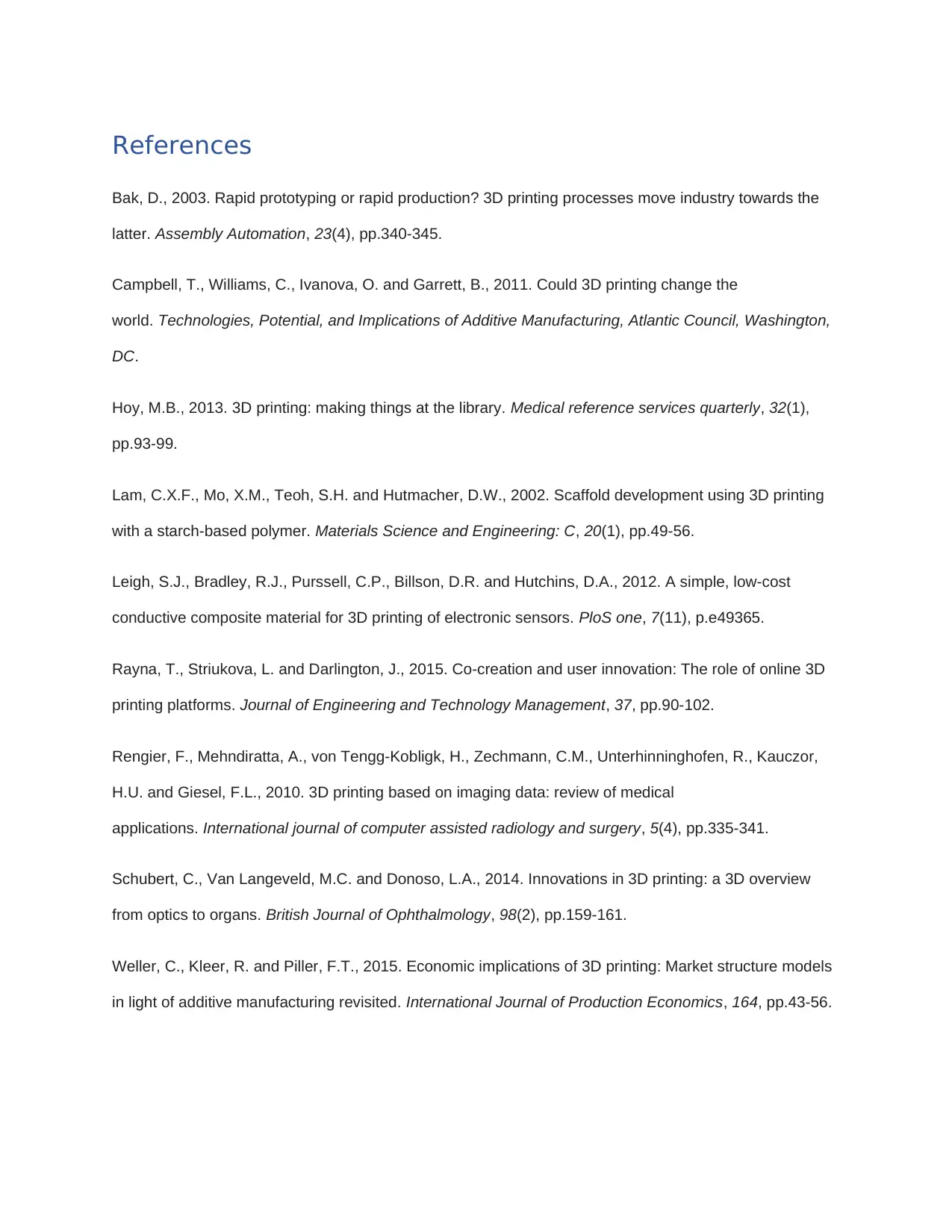
References
Bak, D., 2003. Rapid prototyping or rapid production? 3D printing processes move industry towards the
latter. Assembly Automation, 23(4), pp.340-345.
Campbell, T., Williams, C., Ivanova, O. and Garrett, B., 2011. Could 3D printing change the
world. Technologies, Potential, and Implications of Additive Manufacturing, Atlantic Council, Washington,
DC.
Hoy, M.B., 2013. 3D printing: making things at the library. Medical reference services quarterly, 32(1),
pp.93-99.
Lam, C.X.F., Mo, X.M., Teoh, S.H. and Hutmacher, D.W., 2002. Scaffold development using 3D printing
with a starch-based polymer. Materials Science and Engineering: C, 20(1), pp.49-56.
Leigh, S.J., Bradley, R.J., Purssell, C.P., Billson, D.R. and Hutchins, D.A., 2012. A simple, low-cost
conductive composite material for 3D printing of electronic sensors. PloS one, 7(11), p.e49365.
Rayna, T., Striukova, L. and Darlington, J., 2015. Co-creation and user innovation: The role of online 3D
printing platforms. Journal of Engineering and Technology Management, 37, pp.90-102.
Rengier, F., Mehndiratta, A., von Tengg-Kobligk, H., Zechmann, C.M., Unterhinninghofen, R., Kauczor,
H.U. and Giesel, F.L., 2010. 3D printing based on imaging data: review of medical
applications. International journal of computer assisted radiology and surgery, 5(4), pp.335-341.
Schubert, C., Van Langeveld, M.C. and Donoso, L.A., 2014. Innovations in 3D printing: a 3D overview
from optics to organs. British Journal of Ophthalmology, 98(2), pp.159-161.
Weller, C., Kleer, R. and Piller, F.T., 2015. Economic implications of 3D printing: Market structure models
in light of additive manufacturing revisited. International Journal of Production Economics, 164, pp.43-56.
Bak, D., 2003. Rapid prototyping or rapid production? 3D printing processes move industry towards the
latter. Assembly Automation, 23(4), pp.340-345.
Campbell, T., Williams, C., Ivanova, O. and Garrett, B., 2011. Could 3D printing change the
world. Technologies, Potential, and Implications of Additive Manufacturing, Atlantic Council, Washington,
DC.
Hoy, M.B., 2013. 3D printing: making things at the library. Medical reference services quarterly, 32(1),
pp.93-99.
Lam, C.X.F., Mo, X.M., Teoh, S.H. and Hutmacher, D.W., 2002. Scaffold development using 3D printing
with a starch-based polymer. Materials Science and Engineering: C, 20(1), pp.49-56.
Leigh, S.J., Bradley, R.J., Purssell, C.P., Billson, D.R. and Hutchins, D.A., 2012. A simple, low-cost
conductive composite material for 3D printing of electronic sensors. PloS one, 7(11), p.e49365.
Rayna, T., Striukova, L. and Darlington, J., 2015. Co-creation and user innovation: The role of online 3D
printing platforms. Journal of Engineering and Technology Management, 37, pp.90-102.
Rengier, F., Mehndiratta, A., von Tengg-Kobligk, H., Zechmann, C.M., Unterhinninghofen, R., Kauczor,
H.U. and Giesel, F.L., 2010. 3D printing based on imaging data: review of medical
applications. International journal of computer assisted radiology and surgery, 5(4), pp.335-341.
Schubert, C., Van Langeveld, M.C. and Donoso, L.A., 2014. Innovations in 3D printing: a 3D overview
from optics to organs. British Journal of Ophthalmology, 98(2), pp.159-161.
Weller, C., Kleer, R. and Piller, F.T., 2015. Economic implications of 3D printing: Market structure models
in light of additive manufacturing revisited. International Journal of Production Economics, 164, pp.43-56.
1 out of 10
Related Documents
Your All-in-One AI-Powered Toolkit for Academic Success.
+13062052269
info@desklib.com
Available 24*7 on WhatsApp / Email
![[object Object]](/_next/static/media/star-bottom.7253800d.svg)
Unlock your academic potential
Copyright © 2020–2025 A2Z Services. All Rights Reserved. Developed and managed by ZUCOL.





